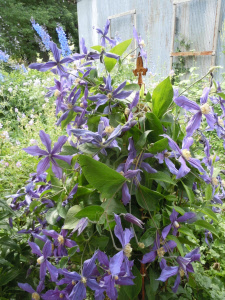Description
Big, deep indigo saucers – all summer into fall. The best short Clematis.
Big blue flowers from June to September
Big, deep indigo saucers – all summer into fall. The best short Clematis.
Powder-blue flowers in early summer; feathery foliage turns caution-sign yellow in fall.
Size: 2-3’ x 2-3’
Care: sun to part shade in moist well-drained soil
Native: Central-So, US
Wildlife Value: attracts butterflies & bees
Awards: Missouri Botanic Garden Plant of Merit; Pennsylvania Horticultural Society Gold Medal; and Mount Cuba Center, botanic garden in Delaware, trialed several Amsonias and gave this its highest rating.
Collected in 1940 in Yell County Arkansas along a stream 3 miles west of Birta.
Clusters of crimson, star-shaped florets atop 2’ stems bloom their heads off ALL summer into fall.
Size: 24-36”x 12”
Care: Sun in well-drained alkaline soil, drought tolerant
Native: Mediterranean
Wildlife Value: attracts butterflies, bees and hover flies.
Centranthus is from the Greek meaning “spurred flower.” According to Culpepper, an English herbalist from the early 1600’s, this plant comforts the heart and stirs up lust. Parkinson, in 1629 describes it “of a fine red colour, very pleasant to behold.”
Brilliant orange with purple spots, turks-cap lily with dramatic, swept-back petals blooming late summer to early fall. Slow to mature but when it does it bears up to 40 flowers on one plant.
Size: 10’ x 12”
Care: Sun in moist to moist-well-drained, acidic soil
Native: from VT to Fl & west to Mississippi River, Wisconsin native
Lilium was named for the Greek word for smooth, polished referring to its leaves. This collected before 1665. In his 1665 book, Flora, seu de Florum Cultura John Rea, nurseryman and author, called it the “Virginia Martagon.” Sold in America’s 1st plant catalog, Bartram’s Broadside, 1783. L.H. Bailey (1913): “The most magnificent and showy of native North American species, well worthy of extensive cultivation.”
OUT OF STOCK
All summer long, droves of lavender blossoms above a mini pillow of spoon-shaped, glossy foliage.
Size: 6-8” x 6-8”
Care: sun in well-drained soil
Native: southeast France on limestone seacliffs
Wildlife Value: deer resistant, salt tolerant
Described by Linnaeus, 1753. The name Limoniuim comes from the Greek word for meadow.

